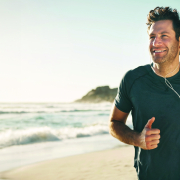Anxious breathing: take control of your breathing like an athlete
What is anxiety?
Anxiety is a common condition that one quarter of Australians will experience in their lifetime. It’s the body’s natural reaction to a threat, or what it thinks is a threat, and can be triggered by a range of things, from
Anxiety can cause your heartbeat and breathing to increase rapidly, along with a host of other symptoms, such as feeling nervous, experiencing headaches, thinking negative thoughts and avoiding the cause of your anxiety.
In this article, we’ll be exploring one of the primary symptoms of anxiety: anxious breathing, and looking at some effective techniques to help you take control of your anxiety.
Anxiety and breathing: what is anxious breathing?
When you’re anxious, your breathing rate increases and it can feel like you just can’t get enough air into your lungs. You might also feel lightheaded, clammy and sweaty, with tingling in your fingers and toes.
Take a (deep) breath
You probably don’t think about your breathing all that often, and why would you? As long as you’re breathing, that’s all that matters, right?
Unfortunately, not quite. Think about this for a moment: actors, elite-level athletes and performance artists all incorporate breathing techniques into their training and work routines.
There’s a good reason for this: focusing on your breathing can boost your physical and mental health – anxiety included.
When you’re stressed, your breathing tends to be irregular and shallow, which can make it harder to get air into your lungs.
Deep breathing – also known as diaphragmatic breathing – is one of the ways to get more air into your body and, in turn, calm your nerves and reduce anxiety.
Think about performing artists before they hit the stage and athletes before they compete or race, you’ll most likely see them using deep breathing techniques to get their nerves (and adrenaline) under control.
The great thing about deep breathing is that anyone can do it. In just a few easy steps, you can use deep breathing to get your anxiety under control.
Deep breathing for anxiety: how to deep breathe
- Find a comfortable spot where won’t be disturbed. You can stand up, sit down or lie on your back – whatever you’re comfortable with
- Put one hand on your upper chest, and the other just below your rib cage. This will help you feel your diaphragm move as you breathe
- Inhale slowly through your nose, drawing the breath down to the stomach. Feel your stomach push against your hand, with your chest remaining still
- Exhale by tightening your abdominal muscles and let the stomach fall downward while exhaling through your mouth – your chest should remain still
- Repeat for 5-10 minutes, until you feel relaxed
How to stop anxious breathing – what other techniques can slow your breathing down?
There are a host of other techniques that can slow your breathing down. It’s important to remember that some of them will work better than others, depending on the person.
What is the 4-7-8 breathing method?
The 4-7-8 breathing technique is an effective tool that, in three easy steps, can help slow your breathing down and ease your anxiety.
To begin, exhale through your mouth. Then, inhale quietly through your nose, counting to four in your head as you do so.
Next, hold your breath for a count of seven, before exhaling completely through your mouth whilst counting to eight in your head.
How does mindful breathing help?
Mindful breathing focuses on bringing your attention to the present and preventing your mind from drifting off and getting lost in thought.
To start mindful breathing, think of a sound, like “om” or a word, like “phew” and repeat it quietly as you inhale and exhale.
You don’t need to do anything to your breath. Not too long, not too short, but natural breaths. Keep going until you feel more relaxed.
If your mind starts to drift or you notice your attention isn’t on your breathing, take a deep breath and return your attention to the present.
Does box breathing work?
Box breathing is a great way to ease anxiety. Start by slowly breathing in through your nose whilst counting to four.
Next, hold your breath for four seconds. Then, slowly exhale through your mouth for four seconds. Finally, hold your breath for your four seconds. Repeat until you feel re-centred.
Where to from here?
We all visit our dentist when we have a toothache. The same goes for our physical health and why we schedule appointments with our GP, gynaecologist, physio, chiro, dermatologist, naturopath… the list is endless.
So why treat our mental health and wellbeing any differently?
Breathing techniques can help you get your breathing under control. In many cases however anxiety and breathing are closely linked. To address breathing issues in these cases, it’s important to start by tackling the root cause: anxiety.
If you’ve been stressed or worried for a long time, or longer than normal, then let’s talk about it. Our psychologists in Australia are located in all major cities and offer telehealth options that make getting psychological help easier.
Access Psych is here to support you. Call us on 1800 277 924 or email info@accesspsych.com.au to get in touch.
Resources
Verywell Mind
Verywell Mind is an award-winning online resource that provides reliable and up-to-date information on a wide range of mental health topics.
With an online library of over 5,500 articles, Verywell Mind offers comprehensive, evidence-based information to help support your mental health concerns. For more, visit: verywellmind.com
Healthline
Healthline is an online source for health guidance. As well as being full of handy information on a range of mental health conditions, including anxiety, Healthline has an impressive number of articles outlining evidence-based techniques to deal with various mental health conditions. For more, visit: healthline.com
For urgent support.
If there’s an immediate risk of harm to yourself or others, please call 000.
If you need someone to talk with now, call:
- Lifeline: 13 11 14
- Beyond Blue: 1300 22 4636 or chat online at beyondblue.org.au
- Suicide Call Back Service: 1300 659 467
The information provided in this document is general in nature and is intended to be used for information purposes only. While we have tried to ensure the accuracy of the information published, no guarantee can be given that the information is free from error or omission or that it is accurate, current or complete.
The information published is not, and should not be relied on as, health or treatment advice. The diagnosis and treatment of any mental illness requires the attention of a physician or other properly qualified mental health professional. If you are seeking diagnosis or treatment of any other mental illness, you should consult a physician or mental health professional. You should not delay in seeking, or disregard, professional health advice because of something you have read in this document.






